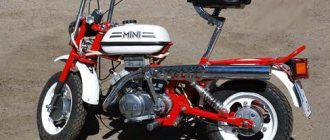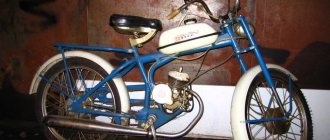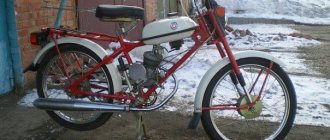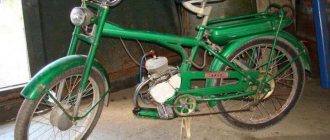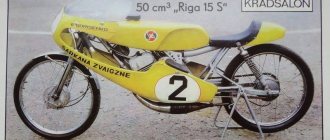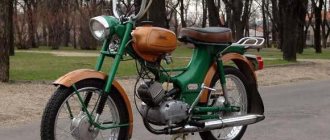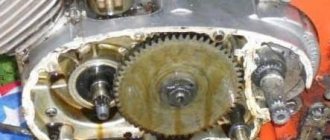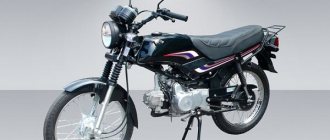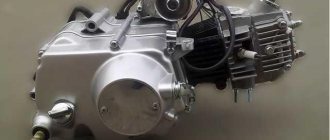We'll ride a moped and the bears won't catch us!
We drove these “cars” without a license, because we were under 16 years old, sometimes the gays raided us, and sometimes we had to run away or hide our mopeds in the bushes, some got into accidents, but nothing could stop our transport - the village is she and there is a village. At that age, technology had some kind of special attractive force for me, and controlling it gave me some kind of feeling of self-confidence, the opportunity to feel like a designer, the master of life. We repaired it ourselves, modernized our equipment, and then boasted to each other about the improvements, some who had the opportunity chromed the fenders, gas tank, headlight, trunk, repainted the frame - in general, full-length tuning. Some tried to force the engines - they reduced the volume of the combustion chamber and ground down the block head, filling it with argon. Life didn't seem boring. There is something to remember.
Light moped-bicycle ZIF-77
ZIF 77 is a Soviet-made light moped, which was produced by the Penza Bicycle Plant named after M.V. Frunze.
This motorbike is a modernized version of the previous model MV-18M and differs from it in improved surface finish of components and parts, as well as new melamine-alkyd enamel. The hole is not heavy at all (its dry weight is 35.2 kg), reaches a maximum speed of 40 km/h, consumes only 1.8 liters of fuel per 100 kilometers with a maximum permissible load of 100 kg.
Unlucky motorcycle Minsk
I got this motorcycle after all the mopeds were stolen, and I just wanted to ride on vacation, and I bought it purely by chance for 80 rubles - which let me down. A neighbor guy was selling it, but I didn’t even ask why it was so cheap. And he sold it only because the engine was overheated; he apparently assembled it purely for sale. In general, he is not a good person. Naturally, the engine immediately knocked, but I didn’t bother to repair the disassembly and asked two hundred rubles from my aunt and went to Motolyubitel and bought a new engine assembly there. I put the motor in my backpack and took it home by train. I quickly threw off the old engine. I installed a new one in anticipation of normal rides. But the damn engine never started - no matter what I did to it - and so my vacation ended. Subsequently, I sold this engine to a friend who worked in a workshop - there he repaired it and sold it cheaply, of course.
This is such a bad thing. I sold the motorcycle without the engine to my future boss and he took it on a train to his village and cheated it on someone there - he made a business. As I later realized, initially this new motor was assembled incorrectly and in the workshop, after disassembly, it was quickly repaired and resold to someone. I never rode a motorcycle again. But soon I got a VAZ-2103, produced in 1973, with a disgracefully shaky chassis, but with a strong body. This is where my skills in repairing equipment that I was not afraid to get into came in handy. Here we had to change almost everything, from empty shock absorbers, broken ball and steering links, to the paint of the body. I could go through these classic Lada cars with my eyes closed; there is no component or assembly that I would not disassemble and repair. Everything always worked for me and the car served me for a long time - about ten years, until the body rotted.
Story
PVZ is one of the oldest engineering enterprises in the USSR for the production of bicycles and defense products, launched in 1915. Initially, this state-owned enterprise was called the “Third Pipe Plant” and was intended for the production of ammunition.
The evacuation of the Petrograd Pipe Plant and the main workshop of the Sestroretsk Arms Factory to Penza in 1918-1919 was of great importance in the formation of the flagship of the Penza industry. 350 skilled workers arrived here along with the equipment. Subsequently, the plant began producing bicycles and in August 1928 the first batch was manufactured.
Photo of the restored motorbike ZIF-77
Penza bicycles were less aesthetically pleasing than “Riga” or Kharkov analogues, but were highly reliable. In October 1931, the plant was renamed into a bicycle plant, and on April 9, 1933, the enterprise was given the name “Penza Plant named after M.V. Frunze” (ZIF).
Before and after the war, the plant was actively involved in the production of weapons, presses, various machine tools and automatic turret lathes. In the 1970s, the plant successfully mastered the production of multi-speed men's and women's bicycles, as well as motorbikes with Red October engines.
Model range overview
The first product of the plant was the 16-V , developed in Kharkov in 1957. The moped had a short-lever front fork and a front brake.
Later, the motorbike was modernized by installing a new D-5 engine, and the “Soviet scooter” itself received a modified name 16B1 .
16-VM model (1963) was already equipped with a new D5M engine, and the front brake became a drum type.
MV-18 motorcycle (1972-1975), compared to the 16 VM, had a completely redesigned frame and got its own original gas tank. The fork has become telescopic, the front brake has changed. The moped was equipped with a new D6 engine from the Krasny Oktyabr plant, which had a light winding in the ignition coil, due to which the mokika now had a rear marker lamp and headlight.
MV-18M modification (1975-1977) differed only in changing the front wing mount, pedal drive and brake.
The headlight mount of the ZIF 77 moped (produced in 1977) became separate from the fork in the form of two chrome-plated loops (rather a deterioration, because it was made of thin metal and could not withstand loads), the rear brake was changed, and the inscription “ZIF-77” appeared on the tank.
Experimental models:
- Motorcycle 17-B (1965) with D5 engine;
- Light moped ZIF-20 with D8 engine
- Riga Stella.
After the collapse of the USSR
During the years of perestroika, the production of light mopeds at the ZIF was discontinued. However, the plant was saved. Renamed in 2008 to Penza Bicycle Plant LLC, it produced seven models of men's and women's road bicycles, as well as two models of teenage bicycles.
The story of one Riga-16 moped
In the fourth grade, my peers, whose parents were by no means poor, got mopeds - Verkhovyna-6 and Riga-16. Since then, I have become obsessed with the desire to also have my own moped. And then my stepfather buys himself a brand new Riga-16. And sometimes he let me ride his equipment - these sensations were unforgettable and I still remember them. And since my stepfather went to work during the day, I began to take his moped without asking to drive around the village and on the Mountain. Well, I took my friend Zhenya with me as a passenger. But my stepfather made sure that his moped was not used in his absence and I had to turn off the speedometer as he recorded the mileage of his moped before leaving for work. I also had to redraw the marks on the plastic canister of gasoline every time, since my cunning stepfather marked the level of gasoline with a ballpoint pen every time, and it was almost impossible for me to get gasoline myself, unless I dumped it somewhere - gas stations did not sell gasoline to children.
And this continued until the 6th grade, until I begged my mother for a ZIF-77 motorbike, after which I could already manage my own transport. It was, of course, worse than a two-speed moped, but it was still not bad, although my rich peers had already switched to Minsk and Voskhod motorcycles, and then to the brand new Javas. But I soon got the treasured Riga-16 in metallic color. One day, my stepfather screwed up his moped very badly - he crashed straight onto the asphalt, drove home and never touched it again. And then I sold my ZIF-77 to a boy from a neighboring village for almost the price of a new one - the expert was his father, a driver, who really liked the technical condition and immediately paid me without haggling. With this money I bought a moped from my stepfather at half price (that’s the kind of family I had). The good stepfather is still a scoundrel.
After that, I quickly put the treasured Riga-16 in perfect order, changed the clutch myself, adjusted the ignition and then the piston and rings and it flew like an airplane! Fussing with technology was a joy for me; I think I would have made a good engineer and I would have been in my place. Often I had to repair the throttle cable, which was constantly fraying, and less often the clutch cable. Well, the light bulbs often burned out and other small things. In general, my equipment was always in good working order and did not let me down in dangerous situations . The story with this moped ended sadly - we got an apartment in the city and moved there to live in the fall, and the moped was immediately stolen from the barn - I even know who - a neighbor's boy with whom we didn't get along. But we didn’t report it to the police, and this guy has been in the other world for a long time - he was poisoned by vodka - what else is there to do in the village?
Specifications
| Engine displacement | 45 cu. cm |
| Number of cylinders | 1 |
| Cylinder diameter | 38 mm |
| Compression ratio | 6 kg/cm |
| Power unit power | 1.2 hp at 4500 rpm |
| Ignition system | from magneto (D6-00-800) |
| Drive unit | Chain |
| Fuel compartment | iron tank with a volume of 4.8 liters and a reserve compartment of 0.2 liters |
| Tire size | 559x48 mm (26x2 inches) |
ZIF-77. Motorcycle sunset.
Greetings to visitors. I would like to talk about the ZIF-77 model of a motorbike from the Frunze plant. His appearance is quite unusual and is remembered by many who have seen him at least once. It so happened that the ZIF bicycle plant was one of the most conservative manufacturers of light motor vehicles in the USSR. In 77-78, he released the “new” model ZIF-77, although it was a modernization of the previous MV-18, -18M. It was a classic motorbike with large wheels (26 inches) with the famous D6 engine.
At this point, other moped manufacturers abandoned the topic of motorbikes. Lvovsky switched to only two-speed models, and Riga, after the technically similar Riga-7, changed the class and began producing the “light moped” Riga-11.
So the ZIF became the last classic motorbike; it continued to be produced in the early 80s. But fashion changed and soon this format was forgotten, and the model became a decline in the production of mopeds for the plant. Although, in addition to its interesting appearance (largely thanks to the triangular gas tank and large wheels), it also had another advantage - light weight. The declared curb weight of 36 kg made it the lightest of the serial motorcycles. There were also no special complaints about reliability, compared to models from other manufacturers, because the D6 engine was the same for everyone. Those who wanted “just a bike with a motor” had to equip regular road bikes with engines themselves.
Only many years later, a light and simple motorbike (also with a D series engine) began to be produced by the Minsk motorbike plant (Krokha motorbike).
A story about my first moped Riga-13: several thousand km on Riga 13
Source
My faithful horse “Dashnik” ZIF-77
The desire to acquire my own equipment for me as a child was simply unbearable - I loved it, apparently I took after my own father - an engineer and technician. He himself made a side trailer for our JAVA at the factory - he calculated everything himself, made drawings and welded everything himself, since he was the chief mechanic at a large factory. This cherry-colored motorcycle is the most vivid memory from my early childhood - how my mother and father took me to the nursery early in the morning on this motorcycle, and I immediately fell asleep on the side trailer in my mother’s arms. And I kept asking my father when he would teach me to ride his motorcycle - I was 3 years old at the time, still a little young - my father suggested that I grow up a little, but he and my mother soon broke up, so I never rode on Java again in my life . And I even remember, on vacation in Crimea, I asked my mother for permission to go and look at someone’s Riga-11 with a tank under the trunk. In general, it gave me great pleasure to go into a sports store and look at mopeds and motorcycles, and even bikes by the way!
And then one day my mother’s heart trembled and we took the train and in the neighboring village bought the cheapest motorbike at a sporting goods store - it was ZIF-77. Oh, and they were collected terribly - compared to Riga, it was just scrap metal bought in a store! Let's start with the fact that before it started, I had to use all the good analytical skills of my mind - it turned out that the light bulb in the headlight had a short to ground - the contacts were mixed up during assembly (probably due to drunkenness, no less), and the pedal drive fell apart immediately - it had to be just throw it away, use a pipe as a footrest instead of pedals, and use only the front brakes. But after reworking the electrician and removing the pedal drive, my little hole went to the rear wheel! And I was only 13 years old then, by the way – I figured it out myself! Subsequently, I also changed the piston myself, and in my opinion I stuck the repair piston into the developed cylinder of the zero category - everything worked, and even the compression really increased, thanks to which it was already possible to drive uphill together.
I modernized my car - I installed a large gas tank from Verkhovyna-6 and a long seat from a children's snow scooter, Chuk and Gek - they were like that, and my transport became a two-seater. Moreover, I rode on it even in winter, and it even worked for me on lighting kerosene due to the lack of gasoline. These trips on my little hole gave me such an insane feeling of high that I began to skip school - my parents went to work in the morning - and I raced on a moped through the surrounding villages and fields! Of course, I abandoned my studies - I got bad marks in the sixth grade and didn’t really know anything about the program. But it was not for nothing that some teachers hated me, who were infuriated by my ability to not go to class and answer the question with five! Then in the eighth grade I took textbooks starting from the third grade and in six months I went through the entire school myself, counting in absentia, and passed the entrance exams to the Suvorov Military School with a strict grade of five - this is where there was a competition for more than 12 people then! And so I did it myself without any cronyism. My head is in order even now - which is what was passed on to my children, the most precious gift.
The most popular moped of its time, ZiF 77
Far, far in the past, or rather in 1915, the Penza plant named after Frunze, or ZiF for short, was built. The main activity of the plant was the production of ammunition, but in 1933 it was decided to produce bicycles and motorbikes there. This was one of the first factories where the production of this equipment was launched. The first model came out in 1957 and was called 16B. In fact, it was an ordinary bicycle with an additionally installed engine and gas tank.
